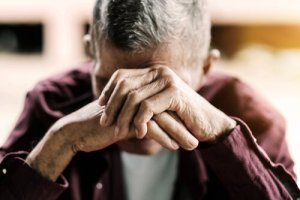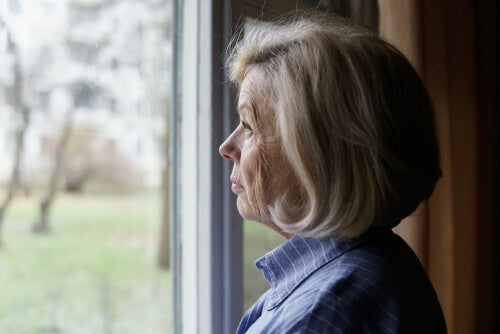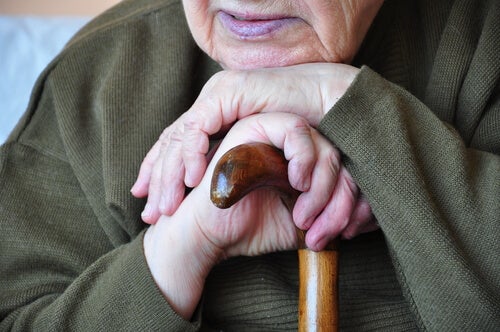Sundowning Syndrome in Elderly People

As people get old, they start to see changes in almost all their habits. Some often say that people, as they grow old, become more maniacal with things such as food, cleaning, sleep, etc. Why does this happen, though? In this article, we’ll be focusing on the changes that occur in the sleep structure of older people, keeping in mind the behaviors that arise with fading daylight. This phenomenon is called evening, crepuscular, sunset or, most commonly, sundowning syndrome.
We could define this syndrome as a state of disorientation that occurs in the late afternoon and extends until nighttime. It can affect anyone, especially as they age. However, it’s more common in people with some type of dementia.
It’s essential to mention that, although it can happen to anyone, it only affects between 10 and 25 percent of patients (Lesta and Petocz, 2004).
According to González and Sardinia (2015), Dewing stated that this condition was difficult to properly define. Nonetheless, he affirmed that it includes periods of extreme agitation and confusion during the late afternoon or early evening hours, which lead to irritability. The patient also experiences behavioral changes.
How it affects people with dementia
According to Echáverri and Erri (2007), sundowning syndrome constitutes one of the most common phenomena in geriatrics. As we previously mentioned, there’s no specific definition of this syndrome. However, we may call it an adverse psychological-behavioral episode. It affects some patients with Alzheimer’s disease in such a way that they become particularly restless, aggressive, and agitated in the last hours of the day.
Sundowning syndrome exacerbates the confusion caused by Alzheimer’s, thus making these patients more noticeable. As a consequence, it brings to the surface dementia-related behavioral, emotional, and cognitive problems.

Signs and symptoms of sundowning syndrome
As Gimenez and Macias said, the origin or cause of this syndrome can be a malfunction of circadian sleep rhythms caused by Alzheimer’s disease. Another cause may be an alteration in the perception of light associated with old age.
Some of the causes that can lead to this syndrome could be the social isolation and the darkness of the sunset. Another may be polypharmacy, which the World Health Organization defines as the use of three or more medications at the same time.
Although there isn’t a defined clinical picture, some of the symptoms of this syndrome, according to Gimenez and Macias (2015), are:
- Increased disorientation.
- Confusion.
- Hyperactivity.
- Aggressive behavior.
- Anxiety.
Other symptoms that also manifest, according to Echáverri and Erri (2007), are the following:
- Restrained monologues, lively discussions, shouting, cursing, and voice suppression.
- Apathy and depression.
- Headaches.
- Ambulatory behaviors and an increase in nocturnal activity which, as a result, leads to insomnia.
- Paranoid thinking and screaming.

How to better manage sundowning syndrome
In addition to pharmacology, it’s important to keep the following recommendations in mind:
- Establish regular life habits.
- Discard intercurrent infection. In other words, make sure this syndrome isn’t interacting with another condition.
- Keep the person busy with simple activities.
- Don’t take daytime naps.
- Reduce the amount of noise.
- Ensure proper lighting.
- Avoid caffeinated drinks.
- Ensure they don’t take drugs that may lead to this syndrome.
That being said, we must bear in mind that the use of multisensory therapy or snoezelen can relieve the signs and symptoms of this syndrome.
In conclusion, there isn’t a lot of information on sundowning syndrome. It’s necessary to understand the factors that lead to different alterations in order to act accordingly. Only then will the quality of life of patients improve significantly.
All cited sources were thoroughly reviewed by our team to ensure their quality, reliability, currency, and validity. The bibliography of this article was considered reliable and of academic or scientific accuracy.
- Echávarri, C., & Erro, M. E. (2007). Trastornos del sueño en el anciano y en las demencias. In Anales del Sistema Sanitario de Navarra (Vol. 30, pp. 155-161). Gobierno de Navarra. Departamento de Salud.
- Giménez, I. G., & Macías, I. C. (2015). Estimulación multisensorial en el síndrome crepuscular. Revista electrónica de terapia ocupacional Galicia, TOG, (21), 13.
- Toledo, Á. M. Correlatos de incidencia del ocaso en estados anímicos, agitación y conducta agresiva en ancianos: Síndrome de Sundowning.
This text is provided for informational purposes only and does not replace consultation with a professional. If in doubt, consult your specialist.








